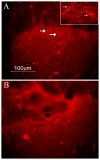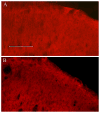Involvement of spinal serotonin receptors in electroacupuncture anti-hyperalgesia in an inflammatory pain rat model
- PMID: 21556842
- PMCID: PMC3581079
- DOI: 10.1007/s11064-011-0495-1
Involvement of spinal serotonin receptors in electroacupuncture anti-hyperalgesia in an inflammatory pain rat model
Abstract
We previously showed that electroacupuncture (EA) activates medulla-spinal serotonin-containing neurons. The present study investigated the effects of intrathecal 5,7-dihydroxytryptamine creatinine sulfate, a selective neurotoxin for serotonergic terminals, the 5-hydroxytryptamine 1A receptor (5-HT1AR) antagonist NAN-190 hydrobromide and the 5-HT2C receptor (5-HT2CR) antagonist SB-242,084 on EA anti-hyperalgesia. EA was given twice at acupoint GB30 after complete Freund's adjuvant (CFA) injection into hind paw. CFA-induced hyperalgesia was measured by assessing hind paw withdrawal latency (PWL) to a noxious thermal stimulus 30 min post-EA. Serotonin depletion and the 5-HT1AR antagonist blocked EA anti-hyperalgesia; the 5-HT2CR antagonist did not. Immunohistochemical staining showed that spinal 5-HT1AR was expressed and that 5-HT2CR was absent in naive and CFA-injected animals 2.5 h post-CFA. These results show a correlation between EA anti-hyperalgesia and receptor expression. Collectively, the data show that EA activates supraspinal serotonin neurons to release 5-HT, which acts on spinal 5-HT1AR to inhibit hyperalgesia.
Figures







Similar articles
-
The Involvement of Descending Pain Inhibitory System in Electroacupuncture-Induced Analgesia.Front Integr Neurosci. 2019 Aug 21;13:38. doi: 10.3389/fnint.2019.00038. eCollection 2019. Front Integr Neurosci. 2019. PMID: 31496944 Free PMC article. Review.
-
Electroacupuncture inhibition of hyperalgesia in an inflammatory pain rat model: involvement of distinct spinal serotonin and norepinephrine receptor subtypes.Br J Anaesth. 2012 Aug;109(2):245-52. doi: 10.1093/bja/aes136. Epub 2012 May 23. Br J Anaesth. 2012. PMID: 22628394 Free PMC article.
-
Spinal Serotonin 1A Receptor Contributes to the Analgesia of Acupoint Catgut Embedding by Inhibiting Phosphorylation of the N-Methyl-d-Aspartate Receptor GluN1 Subunit in Complete Freund's Adjuvant-Induced Inflammatory Pain in Rats.J Pain. 2019 Jan;20(1):16.e1-16.e16. doi: 10.1016/j.jpain.2018.07.011. Epub 2018 Aug 10. J Pain. 2019. PMID: 30102991
-
Rostral ventromedial medulla μ, but not κ, opioid receptors are involved in electroacupuncture anti-hyperalgesia in an inflammatory pain rat model.Brain Res. 2011 Jun 13;1395:38-45. doi: 10.1016/j.brainres.2011.04.037. Epub 2011 Apr 28. Brain Res. 2011. PMID: 21565329 Free PMC article.
-
Involvement of opioid receptors in electroacupuncture-produced anti-hyperalgesia in rats with peripheral inflammation.Brain Res. 2004 Sep 10;1020(1-2):12-7. doi: 10.1016/j.brainres.2004.05.067. Brain Res. 2004. PMID: 15312782
Cited by
-
Auricular vagus nerve stimulation enhances central serotonergic function and inhibits diabetic neuropathy development in Zucker fatty rats.Mol Pain. 2018 Jan-Dec;14:1744806918787368. doi: 10.1177/1744806918787368. Epub 2018 Jun 19. Mol Pain. 2018. PMID: 29921169 Free PMC article.
-
The degree of acute descending control of spinal nociception in an area of primary hyperalgesia is dependent on the peripheral domain of afferent input.J Physiol. 2014 Aug 15;592(16):3611-24. doi: 10.1113/jphysiol.2013.266494. Epub 2014 May 30. J Physiol. 2014. PMID: 24879873 Free PMC article.
-
The Involvement of Descending Pain Inhibitory System in Electroacupuncture-Induced Analgesia.Front Integr Neurosci. 2019 Aug 21;13:38. doi: 10.3389/fnint.2019.00038. eCollection 2019. Front Integr Neurosci. 2019. PMID: 31496944 Free PMC article. Review.
-
Molecular mechanisms underlying the effects of acupuncture on neuropathic pain.Neural Regen Res. 2013 Sep 5;8(25):2350-9. doi: 10.3969/j.issn.1673-5374.2013.25.006. Neural Regen Res. 2013. PMID: 25206545 Free PMC article.
-
The Role of Neuroglial Crosstalk and Synaptic Plasticity-Mediated Central Sensitization in Acupuncture Analgesia.Neural Plast. 2021 Jan 18;2021:8881557. doi: 10.1155/2021/8881557. eCollection 2021. Neural Plast. 2021. PMID: 33531894 Free PMC article. Review.
References
-
- Cheng X. Chinese Acupuncture and Moxibustion. Foreign Languages Press; Beijing: 1999.
-
- Bullock ML, Pheley AM, Kiresuk TJ, Lenz SK, Culliton PD. Characteristics and complaints of patients seeking therapy at a hospital-based alternative medicine clinic. J Altern Complement Med. 1997;3:31–37. - PubMed
-
- Diehl DL, Kaplan G, Coulter I, Glik D, Hurwitz EL. Use of acupuncture by American physicians. J Altern Complement Med 1997. 1997;3:119–126. - PubMed
-
- Zhao Z. Neural mechanism underlying acupuncture analgesia. Prog Neurobiol. 2008;85:355–375. - PubMed
-
- Lao L, Zhang R-X, Zhang G, Wang X, Berman BM, Ren K. A parametric study of electroacupuncture on persistent hyperalgesia and Fos protein expression in rats. Brain Res. 2004;1020:18–29. - PubMed
Publication types
MeSH terms
Substances
Grants and funding
LinkOut - more resources
Full Text Sources
Medical

